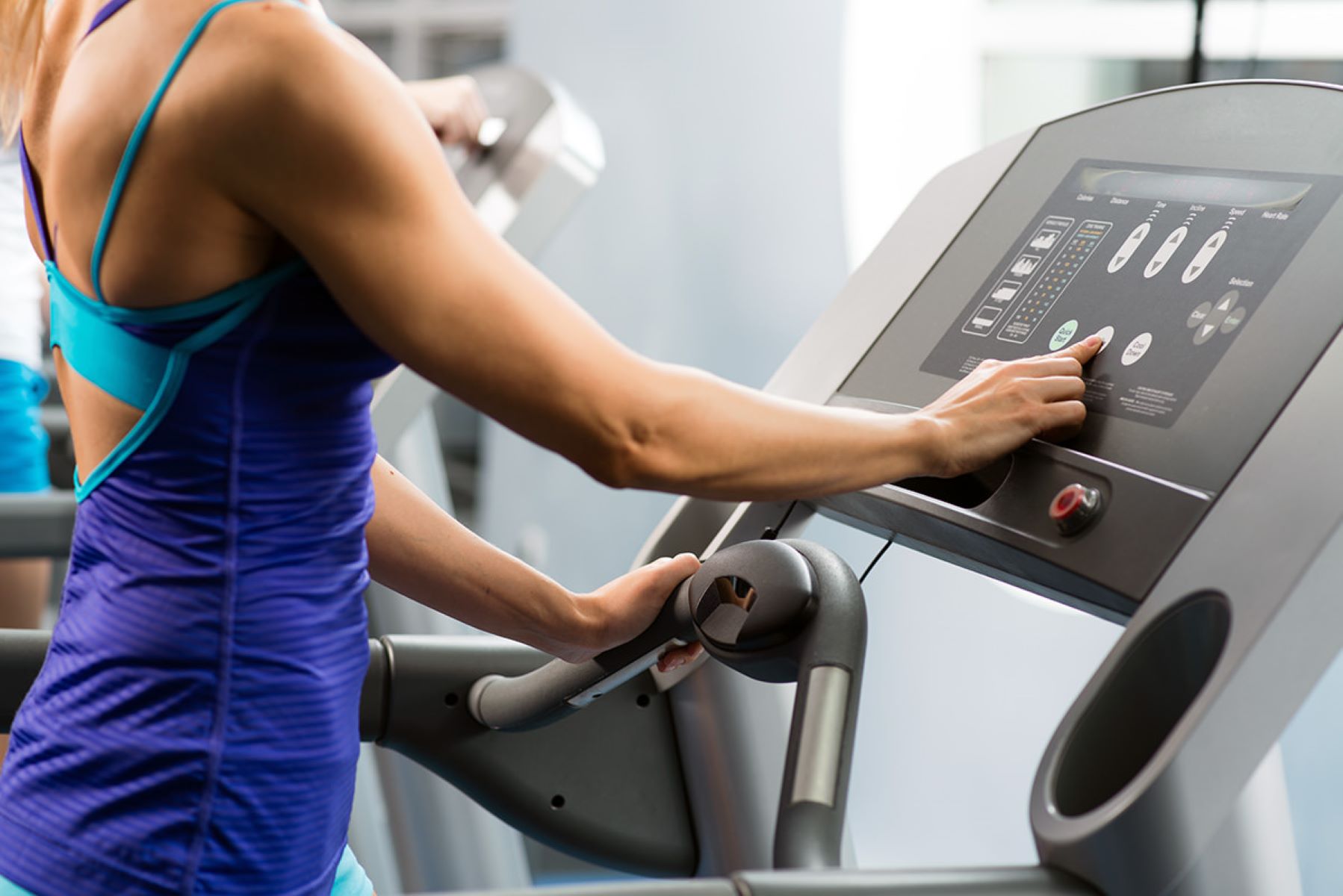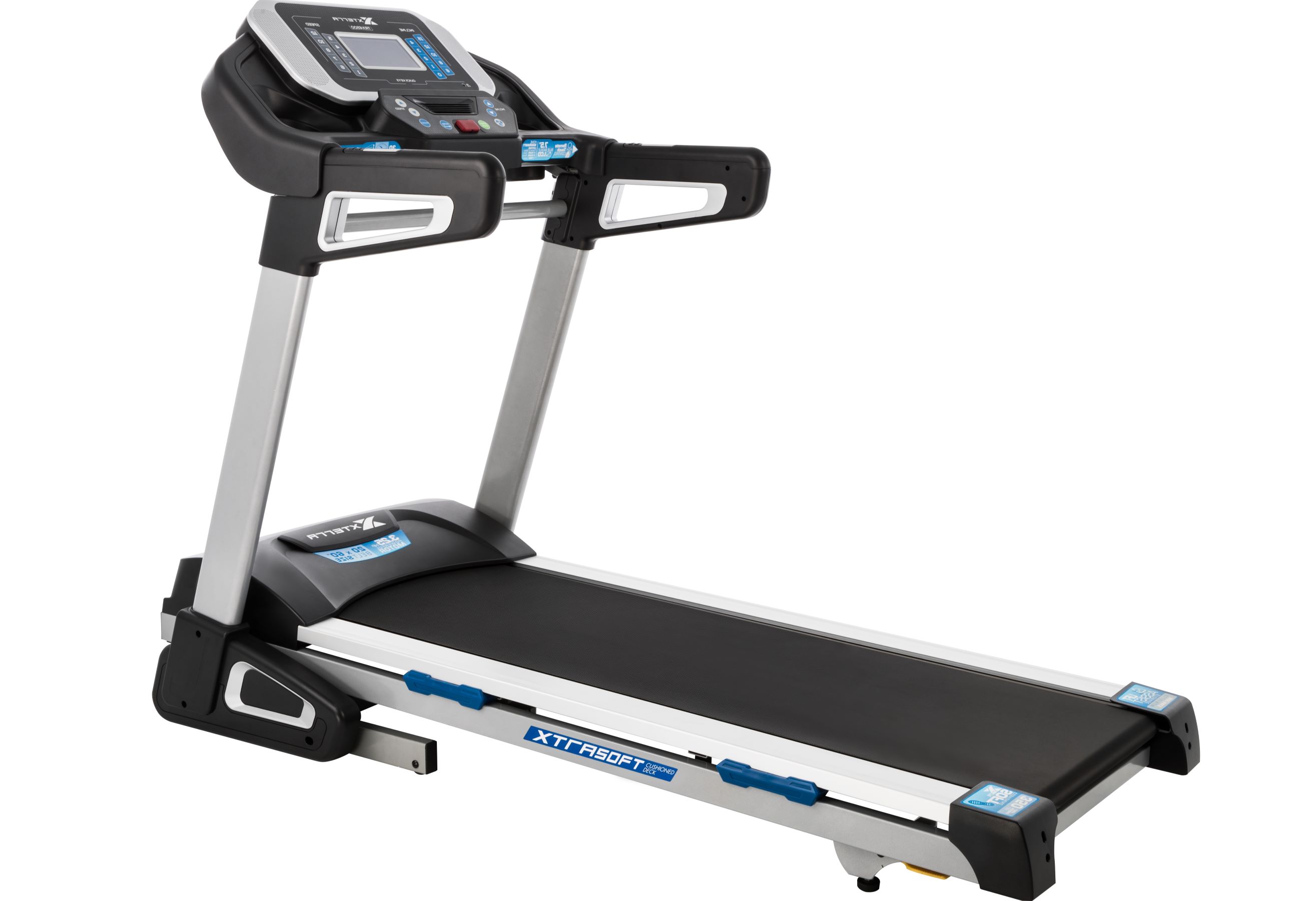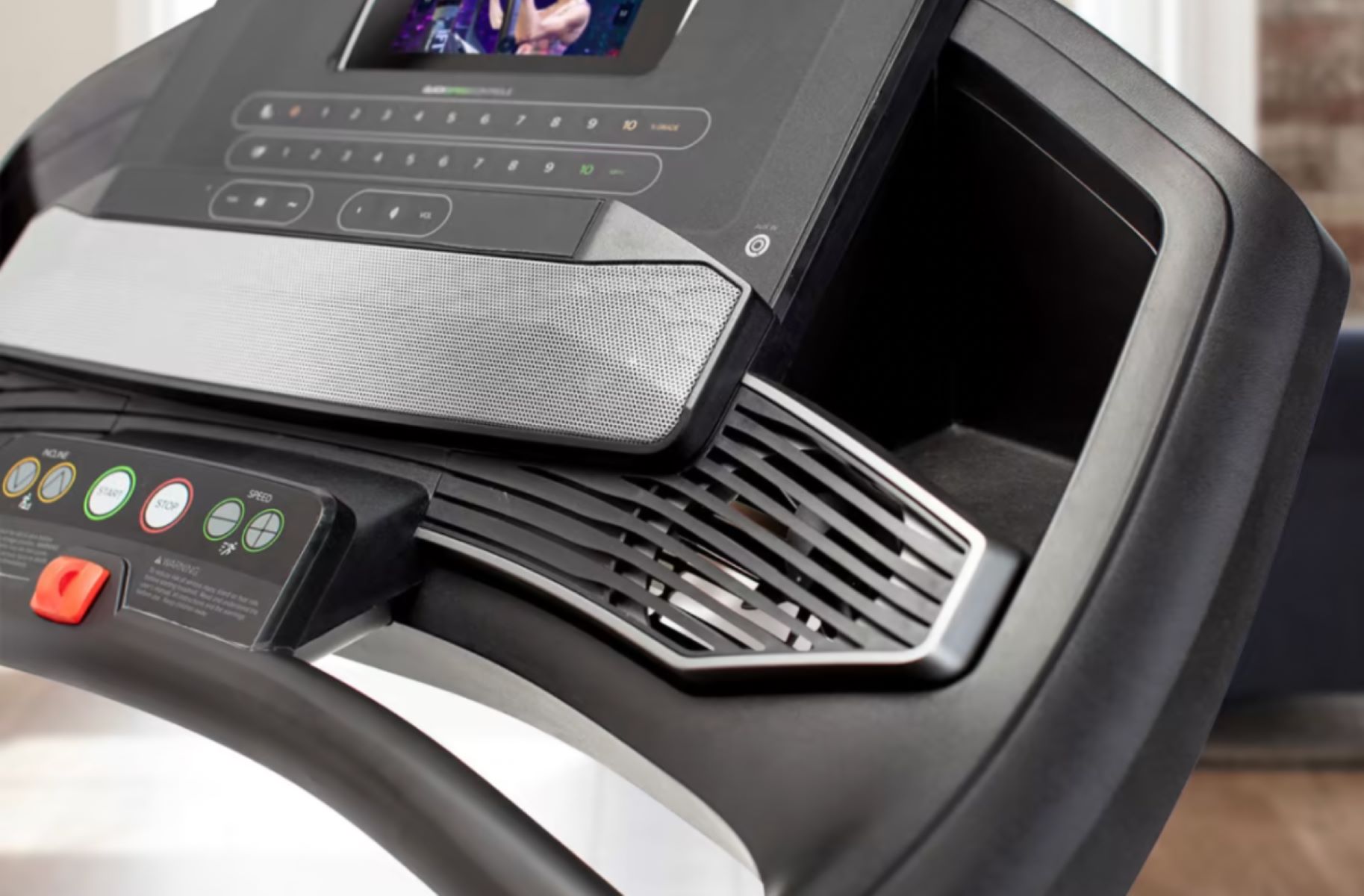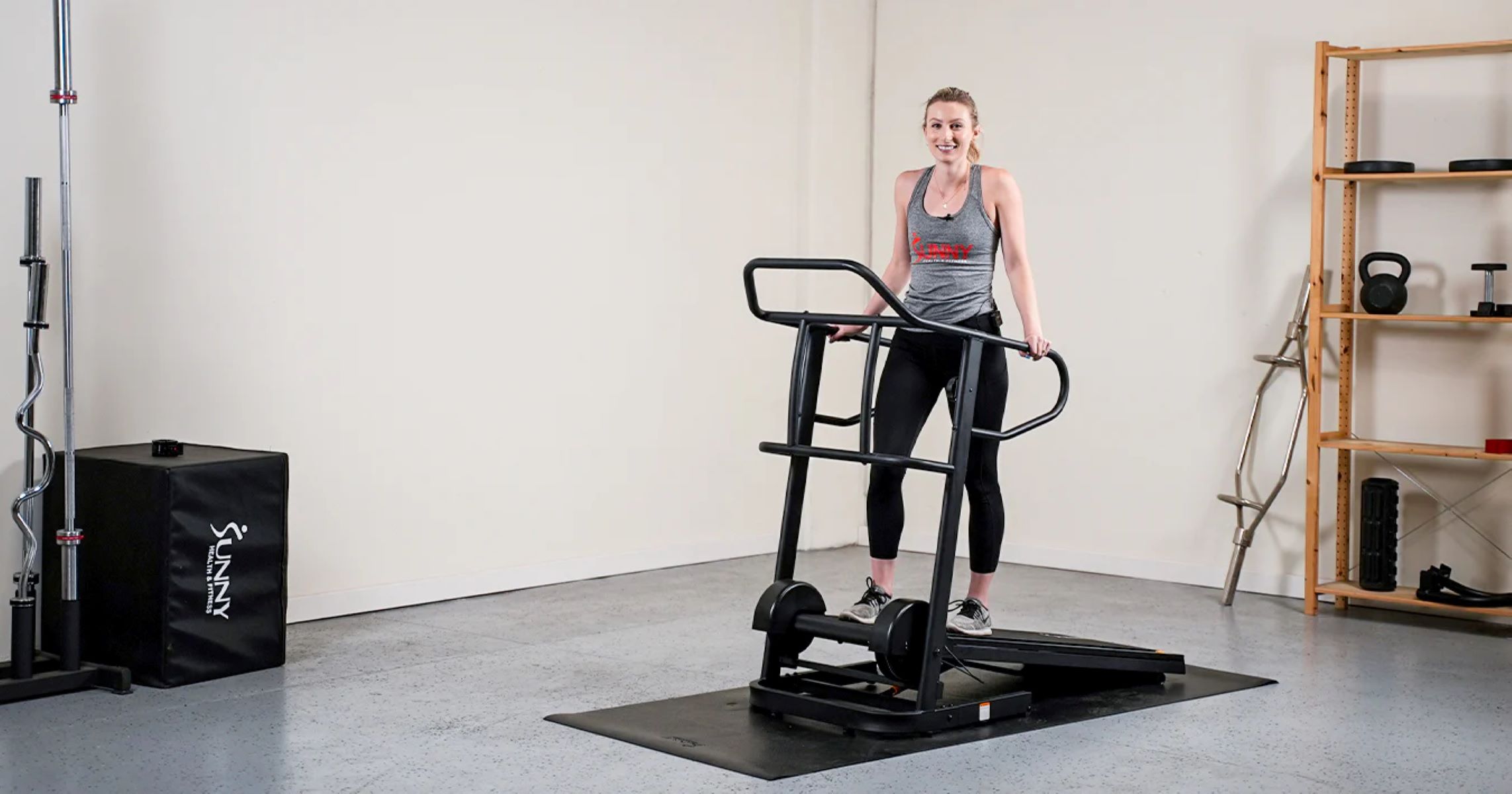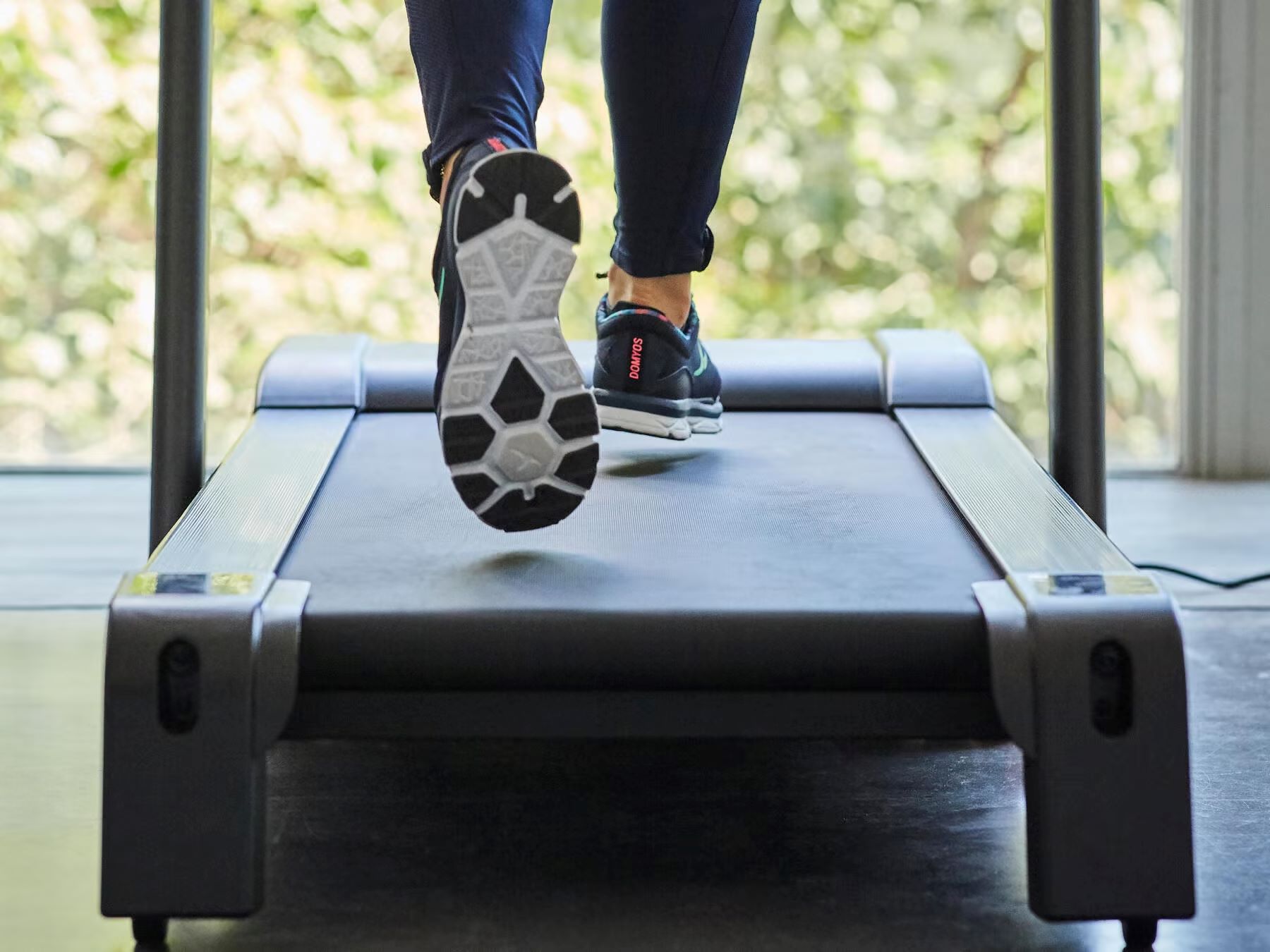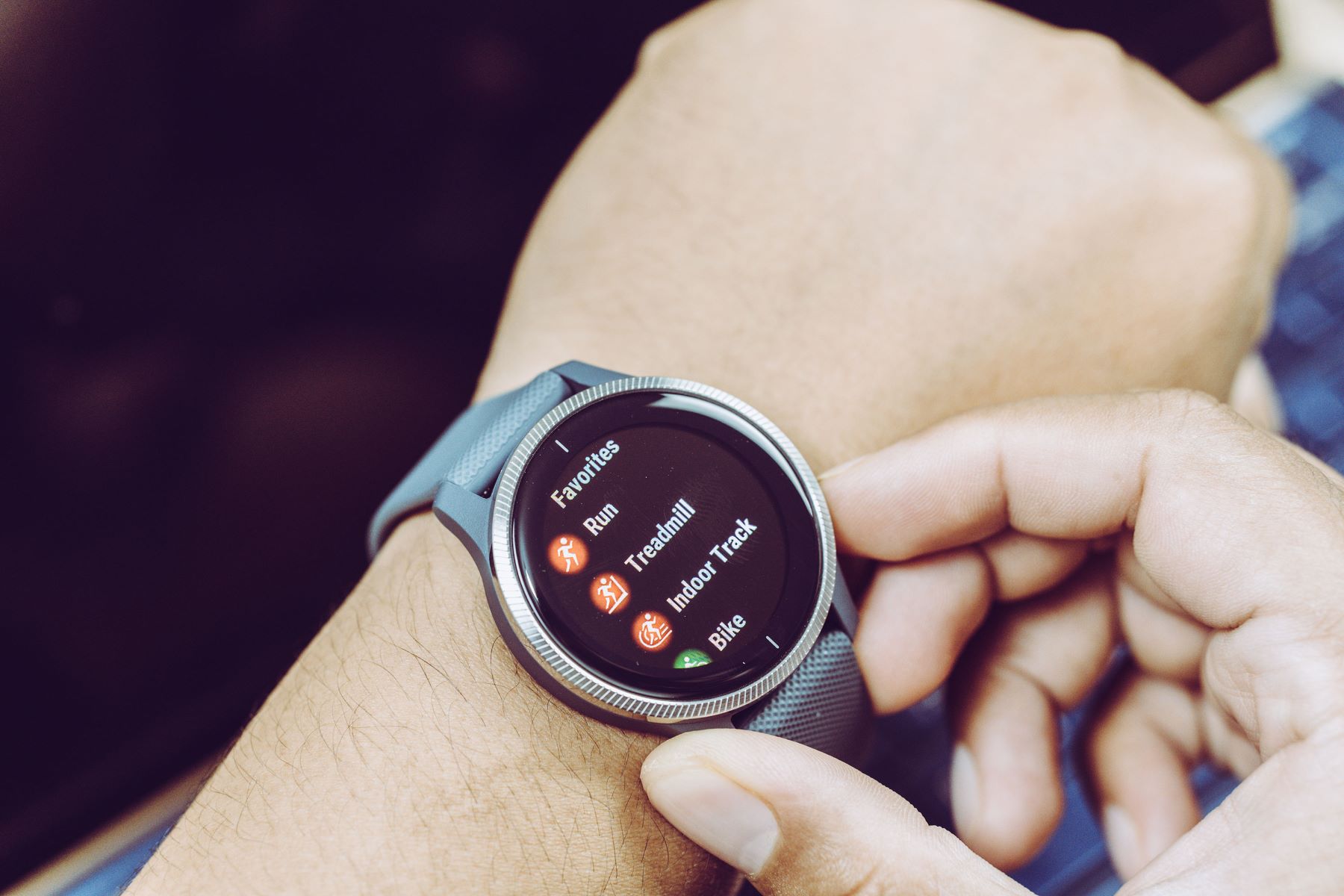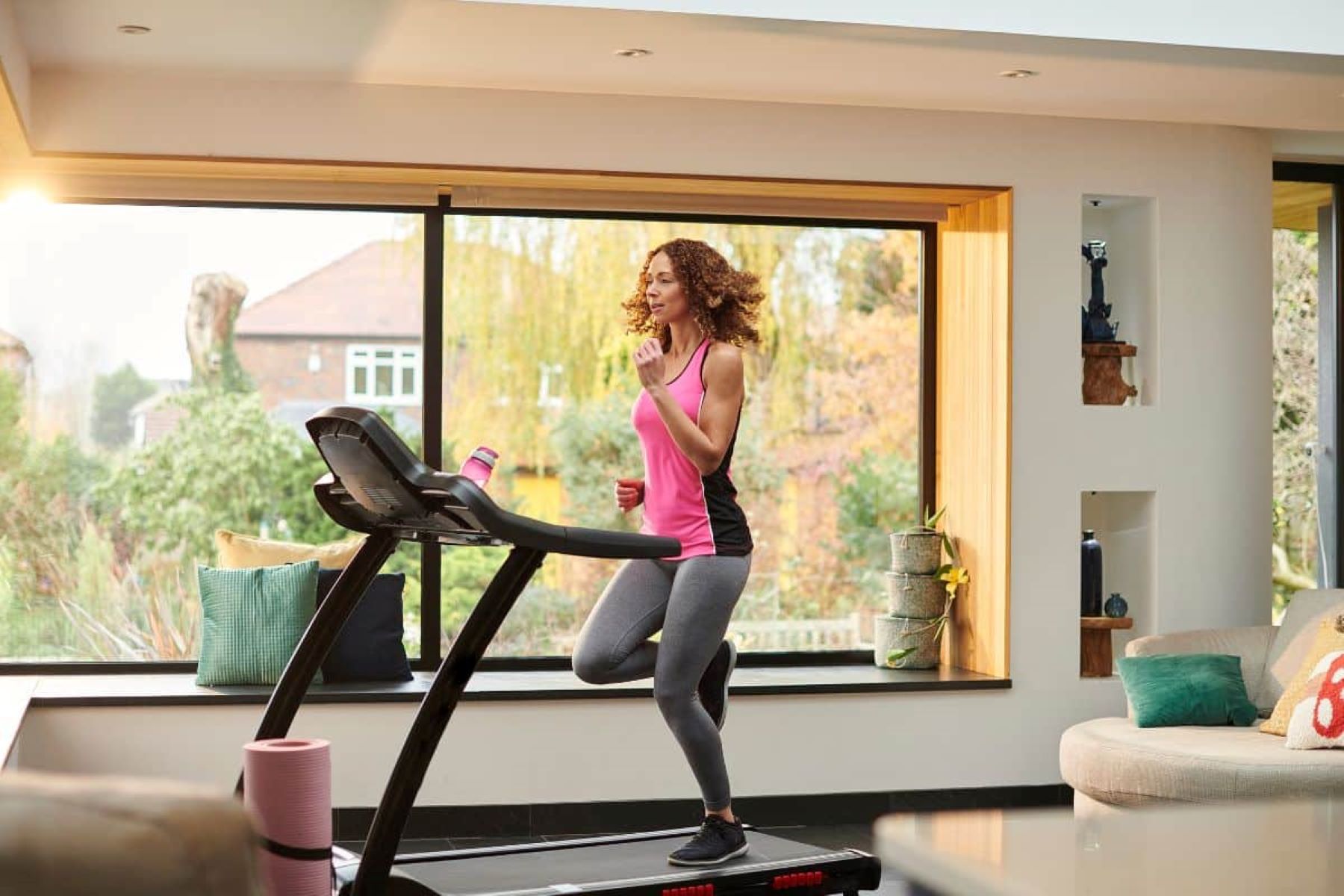

Featured
How To Use The Treadmill
Modified: March 2, 2024
Learn how to use the treadmill effectively with our featured guide. Achieve your fitness goals with proper technique and maximize results.
Introduction
Welcome to the world of treadmill workouts! Whether you’re a beginner looking to kickstart your fitness journey or a seasoned athlete wanting to mix up your routine, the treadmill is a versatile and effective tool for achieving your fitness goals. In this article, we will guide you through everything you need to know about using a treadmill, including safety precautions, proper warm-up and cool-down techniques, different workout intensities, monitoring heart rate, maintaining good form, and tracking your progress.
The treadmill offers numerous benefits that make it a popular choice among fitness enthusiasts. One of the key advantages is the convenience it provides. With a treadmill at home or at the gym, you have the flexibility to exercise whenever it suits your schedule, regardless of the weather conditions outside. Additionally, the treadmill allows for controlled and customizable workouts, allowing you to adjust speed, incline, and intensity levels according to your fitness level and goals.
Another advantage of treadmill workouts is the ability to reduce the impact on your joints. Many treadmills come equipped with shock absorption systems that help cushion the impact of each step, reducing the stress on your knees, ankles, and hips. This makes it a safer option for individuals with joint issues or those who are recovering from an injury.
Furthermore, the treadmill offers a wide range of workout possibilities. Whether you prefer a gentle walk, a challenging uphill run, or high-intensity interval training, the treadmill can accommodate your fitness preferences. You can also simulate different terrains, such as hills or flat surfaces, by adjusting the incline settings, providing a varied and engaging workout experience.
Now that you understand the benefits of using a treadmill, let’s dive into the details of how to use it effectively and safely. By following the guidelines in this article, you will be able to maximize your treadmill workouts and achieve your fitness goals in no time.
Benefits of Using a Treadmill
Using a treadmill offers a multitude of benefits for both your physical and mental well-being. Whether you are a beginner or an experienced fitness enthusiast, incorporating treadmill workouts into your routine can have a transformative impact on your health. Let’s explore the numerous advantages of using a treadmill:
- Convenience: One of the biggest advantages of using a treadmill is the convenience it provides. With a treadmill at home or at the gym, you have the freedom to exercise whenever it suits your schedule, without being limited by external factors such as weather conditions.
- Controlled Workouts: Treadmills allow for controlled and customizable workouts. You have the ability to adjust various settings such as speed, incline, and workout duration, enabling you to tailor your workout to your individual fitness level and goals.
- Reduced Impact: Many treadmills are equipped with shock absorption systems, which help minimize the impact on your joints. This makes treadmill workouts a safer option for individuals with joint issues or those recovering from injuries.
- Versatility: Treadmills offer a wide range of workout possibilities. Whether you prefer walking, jogging, or running, a treadmill can accommodate your fitness preferences. You can also simulate different terrains by adjusting the incline settings, providing you with a varied and challenging workout experience.
- Cardiovascular Health: Treadmill workouts are excellent for improving cardiovascular health. Regular aerobic exercise on a treadmill helps strengthen your heart, increase lung capacity, and improve blood circulation, reducing the risk of cardiovascular diseases.
- Weight Management: Treadmill workouts can be effective for weight loss and weight management. Running or brisk walking on a treadmill helps burn calories and enhance metabolism, contributing to achieving and maintaining a healthy weight.
- Mood Enhancement: Exercise, including treadmill workouts, releases endorphins in the brain, which are natural mood boosters. Regular treadmill sessions can help reduce stress, anxiety, and symptoms of depression, leading to improved mental well-being.
- Goal Tracking: Many modern treadmills come with built-in workout programs and tracking features that allow you to monitor your progress. You can track metrics like distance, speed, calories burned, and heart rate, providing you with tangible data to assess your improvement and set new fitness goals.
- Accessibility: Treadmills are accessible to people of all fitness levels. Whether you are just starting your fitness journey or an experienced athlete, the treadmill can be adjusted to accommodate your current fitness level and gradually increase the intensity as you progress.
Now that you are aware of the numerous benefits of using a treadmill, you can make the most out of this versatile fitness equipment and take a step towards achieving your health and fitness goals.
Safety Precautions
While using a treadmill can provide a safe and effective workout, it is essential to prioritize your safety to prevent any injuries or accidents. Here are some important safety precautions to keep in mind:
- Consult with a healthcare professional: Before starting any new exercise program, especially if you have pre-existing health conditions or concerns, it’s crucial to consult with a healthcare professional. They can provide guidance on the appropriate intensity, duration, and type of exercise that is suitable for your individual needs.
- Warm-up and cool-down: Prior to getting on the treadmill, it is essential to warm up your body with some dynamic stretches or light cardio exercises to increase blood flow and prepare your muscles for the workout. Similarly, cooling down with stretches after your treadmill session helps gradually bring your heart rate back to normal and prevent muscle soreness.
- Wear appropriate footwear: Ensure that you wear proper athletic shoes with adequate cushioning and support to minimize the impact on your joints and prevent any foot or ankle injuries. Avoid running or walking barefoot on the treadmill.
- Start with a slow pace: If you are new to treadmill workouts, begin with a slow pace and gradually increase the speed and intensity over time. This allows your body to adapt and reduces the risk of strain or injury.
- Utilize safety features: Familiarize yourself with the safety features of your treadmill, such as the emergency stop button or safety clip. Ensure that they are functional and within reach during your workout in case of any unforeseen situations.
- Maintain proper form: Pay attention to your posture and form while using the treadmill. Keep your back straight, shoulders relaxed, and engage your core muscles. Avoid leaning forward or holding onto the handrails excessively, as it can disrupt your natural running or walking motion.
- Stay hydrated: Hydration is important during any workout. Keep a water bottle nearby and take regular sips to stay hydrated throughout your treadmill session.
- Listen to your body: Pay attention to any discomfort or pain during your treadmill workout. If you experience any sharp or prolonged pain, dizziness, or shortness of breath, stop exercising and seek medical attention if necessary.
- Clean and maintain your treadmill: Regularly clean the treadmill surface and keep it free from any debris or objects that may cause accidents. Additionally, follow the manufacturer’s instructions for maintenance and servicing to ensure the longevity and safety of your equipment.
By following these safety precautions, you can minimize the risk of injuries and create a safe environment for your treadmill workouts. Remember, your safety is paramount and should always be a top priority during your exercise routine.
Setting Up the Treadmill
Properly setting up your treadmill is essential to ensure a safe and effective workout. Here are some important steps to follow when setting up your treadmill:
- Choose the right location: Select a suitable location for your treadmill, keeping in mind factors such as space, ventilation, and accessibility. Ensure that the area is well-lit and free from any obstructions that may interfere with your workout.
- Check the power source: Verify that your treadmill is positioned near an electrical outlet or has access to a power source. Additionally, ensure that the power cord is intact and free from any damage.
- Level the treadmill: Adjust the leveling feet or base of the treadmill to ensure that it is stable and level on the floor. This prevents any wobbling or instability during your workout.
- Review the user manual: Familiarize yourself with the user manual provided by the manufacturer. It contains important instructions on assembly, safety guidelines, and maintenance recommendations specific to your treadmill model.
- Adjust the settings: Set the desired incline level and speed according to your fitness level and workout goals. Many treadmills also offer preset workout programs that you can choose from to add variety and challenge to your routine.
- Attach safety features: Ensure that any safety features, such as the emergency stop button or safety clip, are properly attached and within your reach during your workout. These features provide an added layer of safety and can be utilized in case of any emergencies.
- Test the functions: Before starting your workout, test the various functions of the treadmill, such as the speed adjustment, incline settings, and console features. This ensures that everything is in proper working order and allows you to familiarize yourself with the controls.
- Use proper lubrication: refer to your user manual for instructions on lubricating the belt of the treadmill. Regular lubrication helps reduce friction and prolong the life of your treadmill.
- Keep the area clean: Regularly clean the treadmill surface and surrounding area to remove any dust, sweat, or debris that may accumulate during your workouts. A clean workspace ensures a more hygienic and enjoyable exercise experience.
- Follow maintenance guidelines: Adhere to the maintenance recommendations provided by the manufacturer to keep your treadmill in optimal condition. This includes regular inspections, belt tension adjustments, and scheduled service checks.
By following these steps, you can ensure that your treadmill is properly set up and ready for your workouts. Taking the time to set up your treadmill correctly not only enhances your safety but also contributes to a more enjoyable and effective exercise experience.
Basic Treadmill Functions
Understanding the basic functions of a treadmill is crucial to using it effectively and getting the most out of your workouts. Here are the key functions to familiarize yourself with:
- Power On/Off: The power button turns the treadmill on and off. Before stepping onto the treadmill, make sure it is powered on and functioning properly.
- Speed Control: The speed buttons or controls allow you to adjust the speed at which the treadmill belt moves. Increase or decrease the speed based on your preference and workout goals.
- Incline Adjustment: Many treadmills have incline settings that allow you to adjust the angle of the running surface. Increase the incline for a more challenging workout or decrease it for a gentler terrain.
- Preset Workouts: Treadmills often come with built-in workout programs designed to target specific fitness goals. These programs automatically adjust the speed and incline settings to provide a structured and varied workout experience.
- Manual Mode: Manual mode allows you to have full control over the speed and incline settings. You can adjust these settings as per your preference during your workout.
- Console Display: The console display shows important information such as speed, distance, time, calories burned, and heart rate. This information helps you track your progress and stay motivated during your workouts.
- Emergency Stop Button: The emergency stop button is a safety feature that stops the treadmill immediately in case of an emergency or if you need to quickly halt your workout. It is typically located within reach on the console or handlebars.
- Heart Rate Monitor: Some treadmills are equipped with built-in heart rate monitors that allow you to track your heart rate during your workout. This helps you stay within your target heart rate zone and adjust your intensity accordingly.
- Quick Start: The quick start button allows you to begin your workout at a default speed and incline setting, making it convenient for a quick and spontaneous workout.
- Cooling Fan: Some treadmills come with a built-in cooling fan to keep you cool and comfortable during your workout. This feature can be especially beneficial during intense or longer workouts.
By familiarizing yourself with these basic treadmill functions, you can make the most out of your workouts and customize your exercise experience according to your preferences and goals. Remember to refer to your treadmill’s user manual for specific instructions and features based on the model you are using.
Proper Warm-up and Cool-down
Performing a proper warm-up and cool-down before and after your treadmill workouts is vital for injury prevention and maximizing the benefits of your exercise session. Here’s a breakdown of why warm-up and cool-down are important and how to incorporate them into your routine:
- Warm-up: A warm-up session prepares your body for the upcoming exercise and gradually increases your heart rate, circulation, and body temperature. It helps loosen up your muscles and joints, reducing the risk of strains and improving overall performance during your workout. A proper warm-up should include dynamic stretches, such as leg swings, arm circles, walking lunges, or light cardio exercises like a brisk walk or slow jog on the treadmill. Aim for around 5-10 minutes of warm-up before transitioning to more intense exercise.
- Cool-down: Cooling down after your treadmill workout allows your heart rate to gradually return to normal and helps prevent dizziness, muscle soreness, and post-workout discomfort. Similar to the warm-up, the cool-down should involve 5-10 minutes of low-intensity exercise, such as walking or slow jogging, followed by static stretching exercises. Focus on stretching major muscle groups, such as your calves, quadriceps, hamstrings, and chest. Hold each stretch for 15-30 seconds without bouncing or causing discomfort.
- Benefits of Warm-up and Cool-down: Incorporating a proper warm-up and cool-down into your treadmill routine offers numerous benefits. Warm-up exercises increase blood flow, oxygen delivery, and nutrient supply to your muscles, enabling them to perform more efficiently. It also enhances joint range of motion and flexibility, reducing the risk of muscle imbalances and injury. On the other hand, a cool-down gradually returns your body to its pre-exercise state, preventing blood pooling, dizziness, and sudden drops in blood pressure. It also helps improve flexibility, reduce stiffness, and aid in the recovery process after intense exercise.
- Warm-up and Cool-down Tips: To make the most out of your warm-up and cool-down sessions, keep the following tips in mind:
- Gradually increase the intensity of your warm-up to get your heart rate up and blood flowing.
- Focus on dynamic movements that replicate the motions you’ll be doing in your main workout.
- Breathe deeply and stay mindful of your body and any areas of tightness or discomfort during stretching.
- Avoid bouncing or jerking during stretches, and remember to maintain proper posture and alignment.
- Listen to your body and adjust the duration and intensity of warm-up and cool-down exercises based on your fitness level and any specific considerations or injuries.
By incorporating a proper warm-up and cool-down into your treadmill workouts, you can improve performance, reduce the risk of injuries, and enhance your overall fitness experience. Remember, taking the time to properly prepare and recover your body will yield long-term benefits for your health and fitness journey.
Beginner Treadmill Workouts
If you’re new to using a treadmill, it’s important to start with beginner-friendly workouts that gradually build your fitness level and endurance. Here are a few beginner treadmill workouts to get you started:
- Power Walk: This workout focuses on brisk walking to elevate the heart rate and burn calories. Start with a warm-up of 5 minutes at a comfortable pace, then gradually increase the speed to a brisk walk. Aim for a speed where you can still hold a conversation but feel slightly challenged. Maintain this pace for 20-30 minutes, and then gradually reduce the speed for a 5-minute cool-down.
- Interval Training: Interval workouts are great for beginners as they alternate between periods of higher intensity and lower intensity. After a warm-up, alternate between walking at a moderate pace and increasing the speed to a challenging but manageable speed for 1-2 minutes. Repeat this pattern for 20-25 minutes, and then finish with a cool-down at a comfortable pace for 5 minutes.
- Hill Climb: This workout simulates uphill walking, offering an excellent cardiovascular challenge. Start with a warm-up, then increase the incline to a moderate level (around 3-5%) and walk at a comfortable pace for 5-10 minutes. Gradually increase the incline every 2 minutes, aiming for a challenging, uphill climb. Maintain this intensity for 15-20 minutes, and then gradually decrease the incline for a 5-minute cool-down.
- Walk-Jog Intervals: This workout gradually introduces jogging intervals to build your running endurance. Start with a warm-up of brisk walking for 5 minutes. Alternate between jogging for 1 minute and walking for 2-3 minutes. As your fitness improves, gradually increase the duration of jogging intervals and reduce the walking time. Aim for a total workout duration of 20-30 minutes, and end with a 5-minute cool-down walk.
- Treadmill Circuit: Incorporate strength and cardiovascular exercises into your treadmill routine. Start with a warm-up, then alternate between walking or jogging on the treadmill for 2-3 minutes and performing bodyweight exercises, such as squats, lunges, push-ups, or planks, off the treadmill. Repeat this circuit for a total of 20-30 minutes, and then finish with a cool-down walk.
Remember to adjust the speed, incline, and duration according to your fitness level and comfort. It’s important to listen to your body and gradually increase the intensity as you progress. Additionally, don’t forget to cool down with 5 minutes of easy walking and stretch your muscles to promote flexibility and prevent soreness.
These beginner treadmill workouts provide a solid foundation for building your fitness level and preparing you for more challenging workouts in the future. Experiment with different workouts, find what you enjoy the most, and have fun while staying committed to your fitness goals.
Intermediate Treadmill Workouts
Once you’ve built a foundation of fitness and confidence on the treadmill, it’s time to advance to intermediate level workouts that challenge your endurance and push your limits. Here are a few intermediate treadmill workouts to take your fitness journey to the next level:
- Pyramid Intervals: Begin with a warm-up of 5 minutes at a moderate pace. Then, alternate between increasing the speed and decreasing the duration. For example, start with a fast sprint for 30 seconds, followed by a 30-second recovery at a comfortable pace. Then sprint for 45 seconds, recover for 45 seconds, and so on, until you reach 1 minute of sprinting. After reaching the peak, gradually decrease the duration back down to 30 seconds. Finish with a 5-minute cool-down.
- Tempo Run: Start with a warm-up of 10 minutes at an easy pace. Then, increase the speed to a comfortably hard pace, where you can still maintain a conversation but feel challenged. Maintain this tempo pace for 15-20 minutes. Finish with a 5- to 10-minute cool-down at an easy pace.
- Incline Intervals: Begin with a warm-up of 5 minutes at a moderate pace. Set the incline to a challenging level (around 5-7%) and walk or jog at that incline for 2 minutes. Then, reduce the incline to a flat surface and increase the speed for 1 minute. Alternate between the incline and flat intervals for 20-25 minutes. Finish with a 5-minute cool-down.
- Progressive Run: Start with a warm-up of 10 minutes, gradually increasing your speed from an easy pace to a moderate intensity. Then, increase your speed every 5 minutes until you reach a fast, challenging pace. Maintain this pace for 5-10 minutes, and then gradually decrease your speed back to a moderate intensity for 5 minutes. Finish with a 5-minute cool-down.
- Interval Hill Sprints: Begin with a warm-up of 5 minutes at a moderate pace. Increase the incline to a challenging level (around 7-10%) and perform short sprints of 20-30 seconds at a fast pace. Recover with a walk or slow jog for 1 minute. Repeat the hill sprints for a total of 10-15 minutes. Finish with a 5-minute cool-down.
Remember to adjust the speed, incline, and duration of these workouts based on your fitness level and goals. These intermediate treadmill workouts are designed to challenge your cardiovascular fitness, endurance, and speed. As you progress, feel free to increase the intensity, duration, or incorporate variations to keep pushing your limits.
Always start with a proper warm-up and end with a cool-down to prepare your body for the workout and aid in recovery. Also, maintain proper form and listen to your body’s cues to avoid overexertion or injury. Stay hydrated throughout your workout and fuel your body with nutritious foods to support your progress.
By consistently incorporating these intermediate treadmill workouts into your routine, you’ll continue to improve your fitness level, burn calories, and achieve new milestones on your fitness journey.
Advanced Treadmill Workouts
For those who are looking for an extra challenge and have built a solid fitness foundation, advanced treadmill workouts offer intense training sessions to further enhance your endurance, speed, and overall fitness level. Take your treadmill workouts to the next level with these advanced workout ideas:
- Interval Sprints: Begin with a warm-up of 5-10 minutes at a moderate pace. Alternate between short, all-out sprints and recovery periods. For example, sprint at maximum effort for 30 seconds, followed by a 30-second recovery or slower speed. Repeat this cycle for 10-15 minutes. Gradually increase the sprint duration or decrease the recovery time to keep challenging yourself.
- Hill Repeats: Choose a challenging incline (around 7-10%) and run at a moderate pace for a set period of time, such as 1-3 minutes. Recover with an easy jog or walk on a flat surface. Repeat this cycle for a total of 5-10 hill repeats. Increase the duration or speed of the hill repeats as you progress.
- Progressive Incline: Start with a warm-up of 10 minutes at a comfortable pace. Increase the incline by 1% every minute until you reach a challenging gradient. Maintain that incline for 5 minutes, and then gradually decrease the incline by 1% every minute back to a flat surface. Finish with a 5-minute cool-down.
- Fartlek Training: Fartlek, meaning “speed play” in Swedish, involves alternating between periods of intense effort and recovery. During your treadmill workout, incorporate random bursts of sprinting at maximum effort followed by easier-paced intervals. Mix up the speeds and durations to keep your body guessing and adapt to different intensities.
- Long Distance Run: Challenge your endurance by going for a longer duration run on the treadmill. Begin with a warm-up of 10-15 minutes at a moderate pace. Then maintain a steady pace that allows you to run continuously for 45-60 minutes. Adjust the speed to keep a consistent effort level throughout. Slowly decrease the speed for a 5-10-minute cool-down.
Always warm up adequately before starting any advanced treadmill workout. This helps prepare your muscles and gradually elevates your heart rate. As with any intense exercise, listen to your body and adjust the intensity, duration, and speed as needed. Hydrate properly, wear comfortable workout attire, and pay attention to your form throughout the workout.
Remember, these advanced treadmill workouts are designed for individuals who have already established a solid fitness base. It’s essential to progress gradually and adapt the workouts to your individual capabilities and goals. Push your limits while also honoring your body’s needs and recovery time.
Continue challenging yourself with these advanced treadmill workouts to further improve your cardiovascular fitness, speed, and overall endurance. Stay consistent, stay motivated, and enjoy the incredible benefits that advanced treadmill training can bring to your fitness journey.
Monitoring Heart Rate
Monitoring your heart rate during treadmill workouts is a valuable tool for gauging your intensity level, ensuring safety, and optimizing your training. By understanding and effectively using your heart rate as a guide, you can achieve better results and tailor your workouts to meet your goals. Here’s how to monitor your heart rate during treadmill workouts:
- Determine your maximum heart rate: To effectively monitor your heart rate, it’s important to know your maximum heart rate (MHR). The general formula for estimating MHR is 220 minus your age. This gives you a target number to aim for during intense exercise.
- Calculate your target heart rate zones: Different heart rate zones represent different levels of exercise intensity. The most commonly used zones are:
- Warm-up Zone: 50-60% of maximum heart rate. This zone is ideal for the beginning of your workout to gradually increase your heart rate.
- Fat-Burning Zone: 60-70% of maximum heart rate. This zone is ideal for burning fat and improving cardiovascular fitness.
- Aerobic Zone: 70-80% of maximum heart rate. This zone is ideal for overall cardiovascular conditioning.
- Threshold Zone: 80-90% of maximum heart rate. This zone is ideal for improving anaerobic endurance and pushing your limits.
- Maximum Effort Zone: 90-100% of maximum heart rate. This zone represents your maximum exertion level and is used for short bursts of intense exercise.
- Use a heart rate monitor: Invest in a heart rate monitor, either a chest strap or a wrist wearable, to accurately track your heart rate during your treadmill workouts. These devices provide real-time feedback and often offer additional features like recording workout data and setting heart rate alerts.
- Monitor and adjust your intensity: During your treadmill workout, periodically check your heart rate to ensure you’re within your target heart rate zone. Use the heart rate monitor’s display or an app on the treadmill console. If your heart rate is below the desired zone, increase your speed or incline. If it’s too high, slow down or reduce the intensity. Continuously monitoring and adjusting your intensity helps optimize your workout and achieve the desired training effect.
- Recovering heart rate: After the workout, pay attention to your heart rate recovery. It’s a measure of how quickly your heart rate returns to normal post-exercise. A quicker recovery time indicates improved cardiovascular fitness.
- Considerations: Keep in mind that individual factors such as fitness level, medications, and other health conditions can affect heart rate. Consult with a healthcare professional if you have any concerns or questions about monitoring your heart rate during exercise.
By monitoring your heart rate during treadmill workouts, you gain valuable insights into your exercise intensity and can make informed adjustments to optimize your training. It’s an effective way to ensure you’re challenging yourself appropriately and making progress towards your fitness goals. Remember to always prioritize safety, listen to your body, and adjust your workout intensity accordingly.
Maintaining Good Form
When it comes to treadmill workouts, maintaining good form is essential for maximizing efficiency, preventing injuries, and getting the most out of your exercise routine. Here are some key principles to keep in mind to ensure proper form while using the treadmill:
- Posture: Stand tall with your shoulders back and relaxed. Avoid slouching or leaning forward, as it can strain your neck, shoulders, and back. Engage your core muscles to maintain stability and proper alignment throughout your workout.
- Arm Position: Bend your elbows at a 90-degree angle and swing them naturally as you walk or run. Avoid excessive arm movements that may throw off your balance or waste energy.
- Foot Placement: Land on your midfoot or forefoot rather than your heel to promote a more efficient stride and reduce the risk of shin splints. Aim for a smooth and quiet footstrike, avoiding heavy pounding on the treadmill surface.
- Stride Length: Maintain a comfortable and natural stride length. Avoid overstriding, which can lead to inefficient movement and increase the risk of injury. Your feet should land directly beneath your body.
- Head Position: Keep your head in a neutral position, looking straight ahead rather than down at your feet or at the console. This helps maintain proper spinal alignment and reduces strain on your neck and upper back.
- Breathing: Breathe evenly and deeply throughout your workout. Inhale and exhale rhythmically, allowing your breath to naturally sync with your movements. Consider using diaphragmatic breathing (belly breathing) for better oxygenation.
- Handrail Usage: Minimize your reliance on the handrails for support. Lightly rest your fingertips on the handrails if needed for balance, but avoid gripping them tightly or leaning on them excessively. Overreliance on the handrails can alter your posture and mechanics.
- Listen to Your Body: Pay attention to any discomfort or pain during your workout. If you experience sharp or prolonged pain, dizziness, or shortness of breath, it’s important to stop exercising and seek medical attention if necessary.
- Variety and Cross-Training: Incorporate a variety of treadmill workouts as well as cross-training exercises to engage different muscle groups and prevent overuse injuries. This helps maintain balance, strength, and overall fitness.
- Consider Working with a Professional: If you’re new to using a treadmill or have concerns about your form, consider working with a certified fitness professional or personal trainer. They can provide guidance, ensure proper technique, and help you maximize your workout effectiveness.
Remember, maintaining good form on the treadmill not only helps you perform more effectively but also reduces the risk of injuries. By paying attention to your posture, alignment, and technique, you can enjoy safer, more efficient, and more enjoyable treadmill workouts.
Incorporating Interval Training
Interval training is a highly effective method of adding intensity, variation, and challenge to your treadmill workouts. By alternating between periods of high-intensity effort and active recovery, interval training helps improve cardiovascular fitness, burn calories, and boost overall performance. Here’s how to incorporate interval training into your treadmill workouts:
- Warm up: Begin with a 5-10 minute warm-up at a comfortable pace to prepare your muscles and gradually increase your heart rate.
- Work to rest ratio: Determine the desired work to rest ratio for your interval training. For beginners, a 1:1 ratio, such as 30 seconds of high-intensity effort followed by 30 seconds of active recovery, is a good starting point. As you progress, you can increase the work interval or decrease the rest period.
- Choose your intervals: Determine the type of interval you want to perform. Options include sprint intervals, incline intervals, or a combination of both. For sprint intervals, increase the speed to a challenging pace for the work interval, then reduce it to a comfortable pace for the recovery interval. For incline intervals, adjust the incline to a steep gradient for the work interval and reduce it for the recovery interval.
- Set the duration: Decide on the total duration of your interval training session based on your fitness level and goals. Beginners may start with 10-15 minutes and gradually increase the duration over time. Aim for a session that challenges you but is sustainable.
- Progress gradually: As your fitness improves, gradually increase the intensity, duration, or number of intervals to continue challenging yourself and making progress. This can involve increasing the speed, raising the incline, or extending the work interval while maintaining proper form and safety.
- Cooldown: After completing the intervals, finish with a 5-10 minute cooldown at an easy pace to gradually bring your heart rate and breathing back to normal. Use this time to stretch your muscles and promote recovery.
Interval training adds variety and excitement to your treadmill workouts, helping to combat boredom and plateaus. It pushes your limits, improves your cardiovascular fitness, and enhances calorie burn. Remember to stay hydrated, listen to your body, and adjust the intensity or duration of your intervals as needed.
As with any exercise program, it’s important to consult with a healthcare professional or fitness expert if you have any concerns or pre-existing conditions. They can provide guidance on the appropriate intensity and frequency of interval training based on your individual circumstances.
Incorporate interval training into your treadmill workouts to take your fitness to new heights and enjoy the many benefits of this high-intensity training technique.
Using Incline for Variation
When it comes to treadmill workouts, incorporating incline variations can add a new level of challenge and engage different muscle groups. Whether you’re a beginner or an advanced exerciser, adjusting the incline on the treadmill offers a variety of benefits. Here’s how to use incline for variation during your treadmill workouts:
- Engage different muscle groups: Running or walking on an incline recruits more muscles, particularly the calves, glutes, and hamstrings. Increasing the incline adds resistance, forcing these muscle groups to work harder and helping to develop strength and endurance.
- Increased calorie burn: Adding incline to your treadmill workouts increases the intensity and workload, resulting in a higher calorie burn. Walking or running uphill requires more effort, boosting your metabolism and helping you burn more calories during and after your workout.
- Variation and challenge: Using the incline feature on the treadmill adds variety to your workouts and prevents boredom. It challenges your cardiovascular system and muscles in different ways, keeping your routine fresh and exciting.
- Hill simulation: Adjusting the incline on the treadmill allows you to simulate outdoor running or walking on hilly terrain. This can be especially helpful if you’re training for a hilly race or enjoy the challenge of uphill running.
- Gradual progression: Incline variations provide a way to progressively challenge yourself as you become more fit. Start with a lower incline and gradually increase it over time as your fitness level improves.
- Maintaining good form: When running or walking on an incline, it’s important to maintain good form. Keep your posture upright, engage your core muscles, and take shorter, quicker steps to maintain your balance and prevent strain or injuries.
- Interval training with incline: Incorporating intervals with varying incline levels can be an effective way to boost your fitness and calorie burn. Alternate between flat surfaces and inclines of varying intensities to create a challenging and effective interval workout.
- Recovery option: Lowering the incline during a workout can serve as a recovery option. If you’re feeling fatigued or want to catch your breath, decreasing the incline to a flat surface allows you to maintain your workout while giving your muscles a break.
Whether you choose to power walk or run, adjusting the incline on the treadmill can enhance your workout and provide a versatile training experience. Experiment with different incline levels and durations to challenge yourself and explore various muscle groups.
Remember to start with a proper warm-up and gradually increase the incline as you progress through your workout. Be mindful of your form, listen to your body, and make adjustments as needed to ensure a safe and effective workout.
Using incline variations during your treadmill workouts adds a new dimension to your routine, helping you reach your fitness goals while keeping your workouts engaging and enjoyable.
Tracking Progress
Tracking your progress during treadmill workouts is an effective way to stay motivated, monitor your improvements, and work towards your fitness goals. By keeping track of various metrics and consistently assessing your performance, you can make informed adjustments to your workouts and celebrate your accomplishments. Here’s how to effectively track your progress:
- Keep a workout log: Maintaining a workout log allows you to record important details such as distance covered, duration, speed, incline, and perceived effort. This provides a comprehensive view of your progress over time and helps you set realistic goals and identify areas to improve.
- Use technology: Utilize fitness tracking apps or devices that sync with your treadmill or wearable technology to monitor your workouts automatically. These tools provide insights into your pace, distance, heart rate, and calories burned, making it easier to track your progress and analyze your performance.
- Set specific goals: Define specific, measurable goals that are aligned with your fitness objectives. Whether it’s increasing your running speed, covering more distance, or improving your endurance, having clear goals provides a benchmark for tracking progress and maintaining focus.
- Regularly assess performance: Periodically evaluate your progress by performing fitness tests or benchmark workouts. Repeating the same test every few weeks, such as a timed run or a distance challenge, allows you to directly compare your performance and gauge improvements over time.
- Measure body composition: Tracking changes in body composition, such as weight, body fat percentage, or measurements, can provide additional insights into your progress. Keep in mind that changes in body composition may not always correlate with improvements in treadmill performance, as muscle gain and fat loss can sometimes offset each other.
- Take before and after photos: Visual progression can be highly motivating. Take before and after photos to observe changes in your physique, posture, and overall appearance. While changes might not always be drastic, comparing photos side by side can reveal subtle improvements and boost your confidence.
- Mental and emotional feedback: Pay attention to the mental and emotional feedback you experience during your workouts. Notice changes in your perceived effort, comfort levels, and level of enjoyment. Feeling stronger, more confident, or experiencing increased endurance are all signs of progress.
- Celebrate milestones: Acknowledge and celebrate your accomplishments along the way. Whether it’s achieving a new personal best, completing a longer distance, or reaching a milestone in your training plan, celebrating these achievements boosts motivation and reinforces the progress you’ve made.
- Adjust and refine: Regularly review your progress and use the insights gained to adjust and refine your workout routine. Make modifications based on the data you’ve collected, your goals, and feedback from your body. This ensures that you continue to challenge yourself and avoid plateauing.
By tracking your progress on the treadmill, you can see the tangible results of your hard work, stay motivated, and make informed decisions about your training. Remember, progress is not always linear, and there may be ups and downs along the way. Embrace the journey and use your progress as a source of encouragement to keep pushing towards your fitness goals.
Avoiding Common Mistakes
When using a treadmill, it’s important to be aware of common mistakes that can hinder your progress and potentially lead to injury. By understanding and avoiding these mistakes, you can optimize your treadmill workouts and ensure a safe and effective exercise experience. Here are some common mistakes to avoid:
- Skipping warm-up and cool-down: Neglecting to warm up properly before your workout and skipping the cool-down afterward can increase the risk of muscle strains and injuries. Take the time to warm up your muscles with dynamic stretches and gradually increase your pace. Similarly, dedicate a few minutes at the end of your workout for static stretches and gradual reduction in intensity to cool down.
- Overstriding: Overstriding, or taking too long of a stride, can lead to inefficient running or walking form and increase the risk of injury. Strive for a natural stride length where your feet land directly beneath your body, allowing for a smooth and efficient motion.
- Leaning on the handrails: Holding onto the handrails while walking or running on the treadmill can disrupt your natural gait and posture. It can also reduce the engagement of your core muscles and lead to imbalances. Only use the handrails for balance if absolutely necessary, and strive to maintain proper form and balance without relying on them excessively.
- Incorrect foot placement: Ensure that each foot lands in the center of the treadmill belt and avoids hitting the sides or stepping too close to the front edge. Incorrect foot placement can affect your stride and lead to discomfort or accidents.
- Not using proper footwear: Wearing the appropriate athletic shoes with proper cushioning and support is crucial for preventing foot, ankle, and joint injuries. Avoid using worn-out or non-supportive shoes when using the treadmill, as they may not provide adequate shock absorption and stability.
- Improper incline or speed settings: Adjusting the incline or speed too abruptly or selecting settings that are too challenging for your fitness level can lead to muscle strains or joint stress. Gradually increase the intensity or speed over time as your fitness improves, and choose settings that challenge you without compromising your form or putting excessive strain on your body.
- Ignoring pain or discomfort: Listen to your body and pay attention to any signs of pain or discomfort during your treadmill workouts. Pushing through pain can worsen injuries and lead to long-term damage. If you experience sharp or persistent pain, dizziness, or shortness of breath, stop exercising and consult with a healthcare professional.
- Not staying hydrated: It’s important to stay hydrated during your treadmill workouts, especially if you’re engaging in high-intensity or longer sessions. Keep a water bottle nearby and sip water regularly to replenish fluids lost through sweat and help maintain proper bodily function.
- Comparing yourself to others: Everyone has different fitness levels and goals, so comparing your progress to others can be demotivating. Focus on your own journey and celebrate your individual achievements. Remember that consistency and personal improvement are more important than competing with others.
Avoiding these common mistakes can help you maximize the benefits of your treadmill workouts and minimize the risk of injuries. Always prioritize safety, listen to your body, and make gradual progress in terms of intensity and duration. With proper form and technique, you’ll be able to enjoy the many advantages of using a treadmill for your fitness journey.
Conclusion
Using a treadmill is an excellent way to improve your fitness, burn calories, and achieve your health goals. By incorporating the tips and techniques discussed in this article, you can maximize the benefits and enjoyment of your treadmill workouts.
Start by understanding the numerous benefits of using a treadmill, including convenience, controlled workouts, reduced impact, versatility, cardiovascular health, weight management, and mood enhancement. Stay safe by following safety precautions, setting up the treadmill correctly, and maintaining good form throughout your workouts.
As you progress, explore the different levels of treadmill workouts, from beginner to intermediate and advanced. Gradually increase the intensity, duration, and challenge of your workouts to continuously improve your fitness level and reach new milestones.
Track your progress using various methods such as workout logs, fitness apps, body composition measurements, and visual observations. Celebrate your accomplishments and set specific, measurable goals to stay motivated and focused on your fitness journey.
Lastly, avoid common mistakes and prioritize your safety by warming up and cooling down properly, maintaining good form, and staying hydrated. Be mindful of your body, listen to its cues, and make adjustments as needed to prevent injuries and ensure a rewarding workout experience.
Remember, consistency is key. Incorporate the treadmill into your regular exercise routine and make it a habit. With perseverance and dedication, you’ll not only see physical improvements but also experience the mental and emotional rewards that come with achieving your fitness goals.
Now, it’s time to lace up your shoes, hop on the treadmill, and embark on a fulfilling and invigorating fitness journey. Enjoy the process, push your limits, and embrace the transformative power of the treadmill in your pursuit of a healthier and stronger body.
